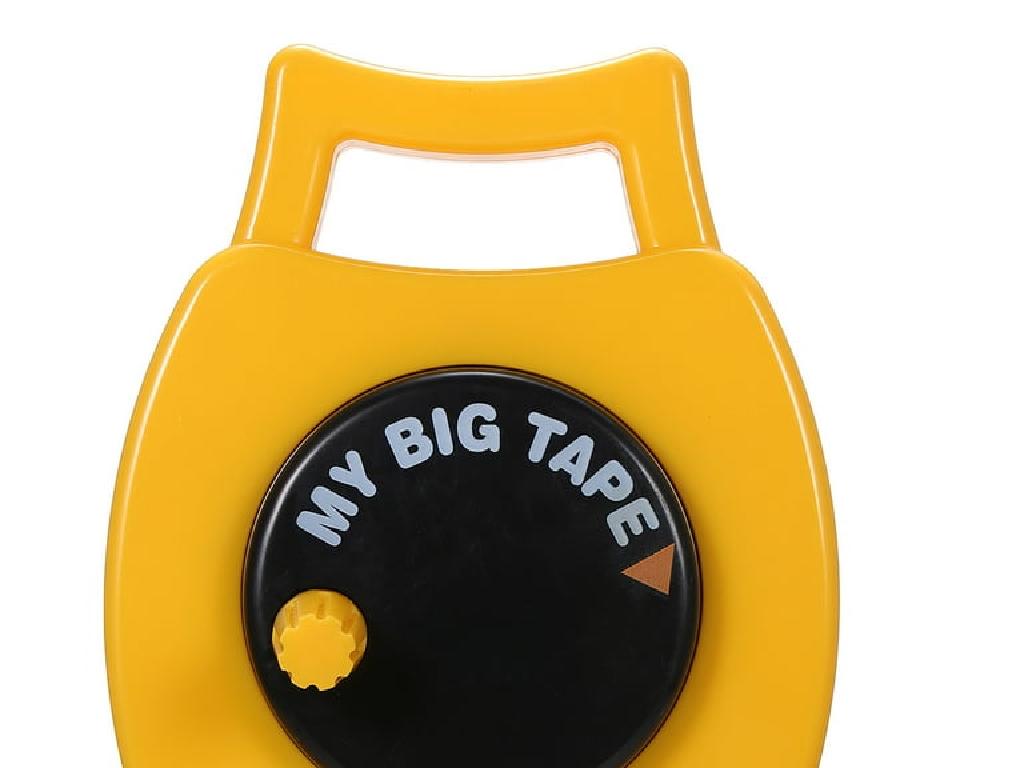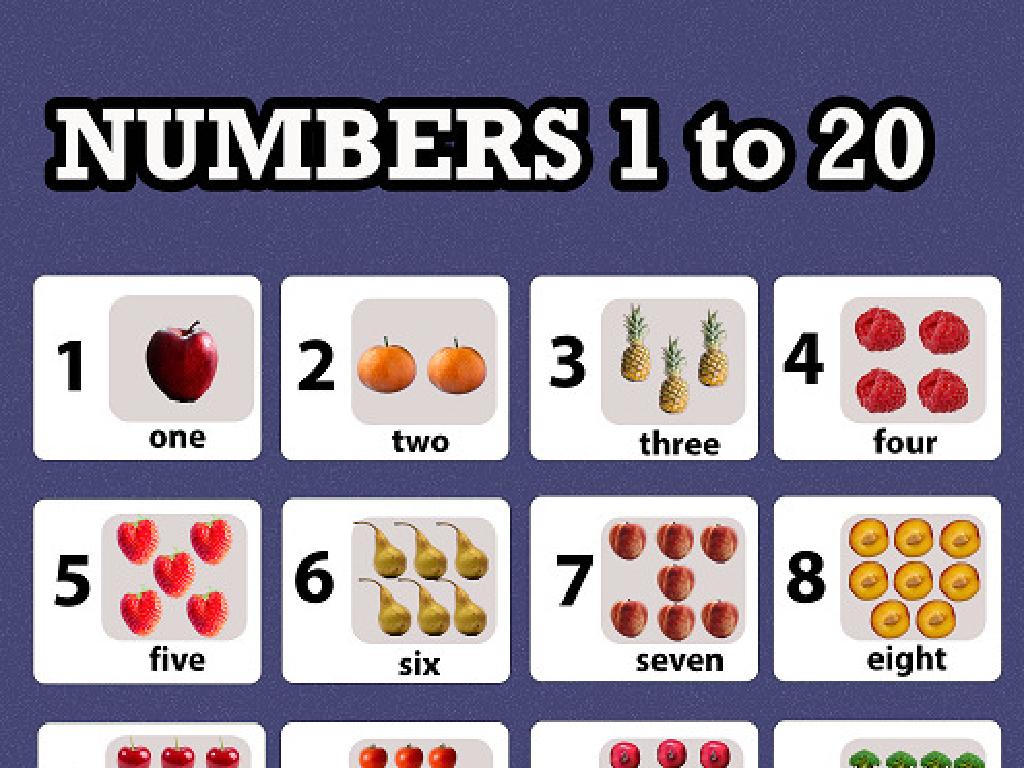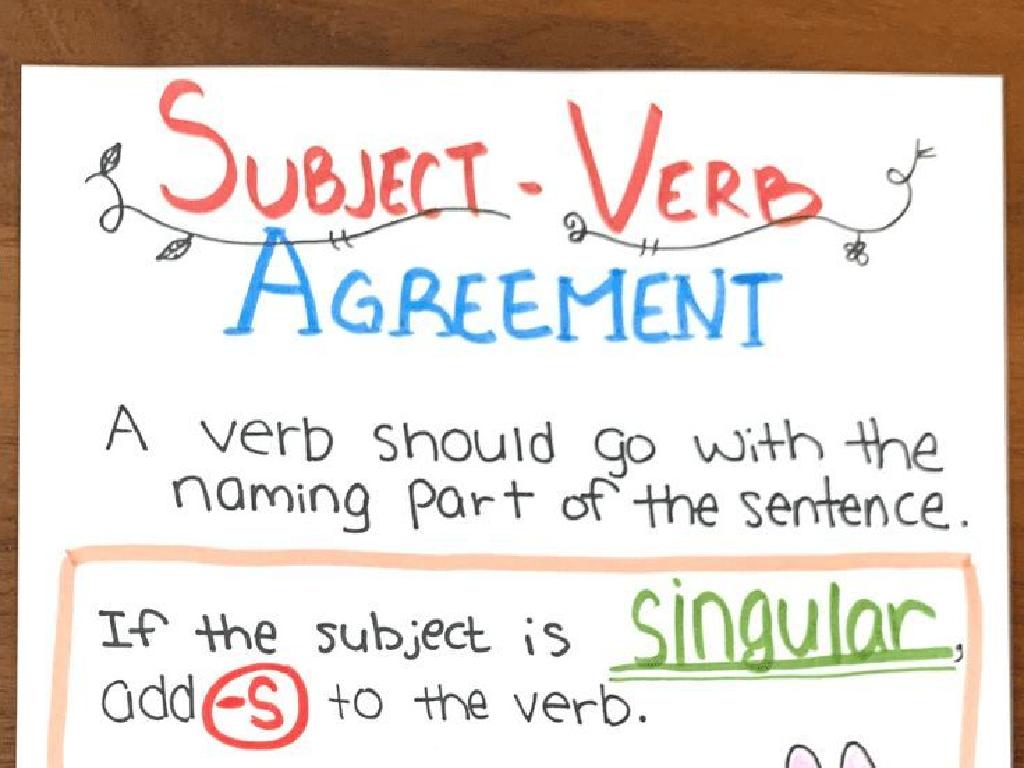Pronoun-Verb Agreement
Subject: Language arts
Grade: Fourth grade
Topic: Verb Types
Please LOG IN to download the presentation. Access is available to registered users only.
View More Content
Welcome to Pronoun-Verb Agreement!
– Greeting and topic introduction
– Understanding pronouns and verbs
– Pronouns replace nouns; verbs show action
– Matching pronouns with verbs
– Pronouns and verbs must agree in number and tense
– Why correct agreement matters
– It helps sentences make sense and sound right
|
Begin the class with a warm welcome and introduce the topic of Pronoun-Verb Agreement as part of our Language Arts lesson. Explain that pronouns are words that take the place of nouns, like ‘he’, ‘she’, or ‘they’, and verbs are action words, like ‘run’, ‘jump’, or ‘is’. Emphasize the importance of using the correct form of a verb to match the subject pronoun in a sentence, which is essential for the sentence to be grammatically correct and clear in meaning. Use examples to illustrate how mismatched pronouns and verbs can lead to confusion. Encourage students to listen carefully and participate in upcoming activities to practice this skill.
Understanding Pronoun-Verb Agreement
– What is a pronoun?
– A word that takes the place of a noun, like ‘he’ or ‘she’.
– Common pronouns list
– Examples: he, she, it, they, we, I, you.
– Pronouns in sentences
– ‘He runs fast.’ ‘They play together.’
– Matching verbs to pronouns
– Ensure the verb form matches the pronoun, like ‘I am’ and ‘she is’.
|
Begin by defining a pronoun as a word that replaces a noun in a sentence, which helps avoid repetition. Introduce common pronouns such as ‘he’, ‘she’, ‘it’, ‘they’, ‘we’, ‘I’, and ‘you’. Provide examples of these pronouns in simple sentences to illustrate their use. Emphasize the importance of verb agreement with pronouns, explaining that verbs must match the subject pronoun in number (singular or plural) and person (first, second, or third). Use examples like ‘I am’ versus ‘she is’ to show singular agreement, and ‘we are’ versus ‘they are’ for plural agreement. Encourage students to create their own sentences using different pronouns and matching verbs.
Understanding Verbs: Action and Linking
– Verbs are action or state words
– Action verbs show what someone/something does
– Examples: ‘jump’, ‘eat’, ‘write’, ‘sing’
– Linking verbs connect subject to more info
– Examples: ‘am’, ‘appear’, ‘become’, ‘feel’
– Examples: ‘run’, ‘think’, ‘is’, ‘seem’
|
This slide introduces the concept of verbs to fourth-grade students. Begin by defining verbs as words that show action or state of being. Highlight that every sentence needs a verb to express what the subject does or is. For action verbs, provide examples like ‘jump’, ‘eat’, ‘write’, and ‘sing’ to illustrate verbs that show action. Then, explain linking verbs such as ‘am’, ‘appear’, ‘become’, and ‘feel’, which do not show action but instead link the subject to additional information about the subject. Use simple sentences to demonstrate how these verbs function within a sentence. Encourage students to come up with their own examples and to identify verbs in sentences they create or read.
Pronoun-Verb Agreement Basics
– Verbs agree with subjects
– A verb must match its subject in number (singular/plural) and person (first/second/third).
– Singular vs. plural verbs
– Singular pronouns like ‘he’ or ‘she’ need singular verbs. Plural pronouns like ‘they’ need plural verbs.
– ‘He runs’ vs. ‘They run’
– Compare: ‘He runs’ (singular) with ‘They run’ (plural).
– Practice with examples
– Let’s try some sentences together to see how it works!
|
This slide introduces the concept of pronoun-verb agreement, which is crucial for correct sentence structure. Start by explaining that verbs need to ‘agree’ with their subjects – this means if the subject is singular, the verb must be singular, and if the subject is plural, the verb must be plural. Use clear examples like ‘He runs’ to show singular agreement and ‘They run’ to show plural agreement. Encourage students to think of verbs as ‘changing their form’ to match the subject. Provide practice sentences for students to apply this rule, and correct as a class. This will help solidify their understanding of subject-verb agreement.
Pronoun-Verb Agreement
– Matching verbs with pronouns
– He runs, they run – ‘runs’ is for ‘he’, ‘run’ is for ‘they’
– Examples of correct pairs
– She sings, not she sing. We are, not we is.
– Examples of incorrect pairs
– They dances, should be they dance. He have, should be he has.
– Tips to avoid common mistakes
– Remember: singular pronouns need singular verbs, plural pronouns need plural verbs.
|
This slide aims to teach students the importance of pronoun-verb agreement in sentences. Start by explaining that verbs must match the pronoun in number (singular or plural). Use clear examples to show the correct pairing of pronouns and verbs, and contrast these with common errors. Emphasize the mistakes often made and provide students with simple tips to remember the correct forms, such as the pronoun ‘he’ with ‘runs’ and ‘they’ with ‘run’. Encourage students to practice by creating sentences and checking if their pronouns and verbs agree. This will help them write more accurately and improve their understanding of subject-verb agreement.
Let’s Practice Pronoun-Verb Agreement!
– Interactive sentence practice
– Choose the correct verb form
– Match the pronoun with the right verb, like ‘he runs’ not ‘he run’
– Class corrects sentences together
– Discuss the correct answers
– Understand why a verb agrees with its pronoun
|
This slide is for an interactive class activity focused on pronoun-verb agreement. Write sentences on the board with the verbs missing, and have students come up to fill in the correct verb form that matches the pronoun in each sentence. Afterward, review the sentences as a class, correcting any mistakes and discussing why the chosen verb forms are correct. Emphasize the importance of subject-verb agreement in making sentences clear and grammatically correct. Possible activities: 1) Students can write their own sentences on the board for peers to correct. 2) Break the class into teams for a friendly competition. 3) Use flashcards with pronouns and verbs for a matching game. 4) Have students create a short story using correct pronoun-verb pairs. 5) Role-play with students using sentences with correct and incorrect verb agreements to identify.
Your Turn to Shine with Pronoun-Verb Agreement!
– Write sentences with correct agreement
– Be creative with pronouns and verbs
– Try using ‘he runs’ or ‘they play’
– Double-check your sentences
– Make sure your pronouns and verbs match
– Share your best sentence with the class
|
This activity slide encourages students to apply their knowledge of pronoun-verb agreement by writing their own sentences. It’s important to remind them that singular pronouns should be matched with singular verbs, and plural pronouns with plural verbs. Encourage them to use a variety of pronouns (he, she, it, they, we) and to pair them with different verbs to show agreement. After writing, they should review their sentences to ensure the pronouns and verbs agree. Finally, ask students to share their sentences with the class to foster a collaborative learning environment. Possible activities: 1) Pair students to peer review each other’s sentences. 2) Create a class bulletin board with their sentences. 3) Have a contest for the most creative sentence. 4) Use the sentences to create a class story.
Class Activity: Pronoun-Verb Agreement Game
– Learn with a matching game
– Work in small groups
– Match pronouns to verbs
– For example, ‘he runs’ not ‘he run’
– Group discussion afterwards
|
This interactive class activity is designed to help students understand pronoun-verb agreement through a fun matching game. Before starting, explain that a pronoun (like ‘he’, ‘they’, ‘it’) must agree with the verb (like ‘runs’, ‘play’) in number and person. Divide the class into small groups and provide each group with a set of pronoun and verb cards. Students will match pronouns to the correct form of the verbs. After the activity, bring the class together to discuss the correct matches. This will reinforce the concept and allow for clarification of any misunderstandings. Possible variations of the game could include using sentences with blanks to fill in, creating a memory game with cards face down, or having a relay race where students run to a board to match cards.
Conclusion: Pronoun-Verb Agreement
– Recap pronoun-verb rules
– Subjects and verbs must agree in number: ‘He runs’ vs. ‘They run’.
– Importance of correct pairs
– Correct pairs improve readability and prevent confusion in sentences.
– Open floor for questions
– Practice makes perfect
– Keep practicing with different pronouns and verbs for mastery.
|
As we wrap up our lesson on pronoun-verb agreement, it’s crucial to revisit the main rules that ensure subjects and verbs match in number. Emphasize how using correct pronoun-verb pairs is essential for clear writing. Encourage students to ask any lingering questions they might have to clarify their understanding. Conclude with the reminder that becoming proficient in this aspect of grammar takes practice, and encourage them to apply these rules in their daily writing. For homework, assign exercises that require them to identify and correct pronoun-verb agreement errors.
Homework: Mastering Pronoun-Verb Agreement
– Complete the pronoun-verb worksheet
– Write a short story with correct pronoun-verb pairs
– Use ‘he runs’ or ‘they run’ to match pronouns with verbs
– Remember to bring your work to class
– Review and discuss our stories together
– We’ll learn from each other’s stories and corrections
|
This homework assignment is designed to reinforce the day’s lesson on pronoun-verb agreement. The worksheet provides structured practice, while the short story encourages creative application of the concept. Remind students to use singular verbs with singular pronouns and plural verbs with plural pronouns. In the next class, we will review the worksheets and stories as a group, allowing students to learn from each other’s work. This peer review process will help solidify their understanding of pronoun-verb agreement. Be prepared to offer guidance and praise for their efforts.






